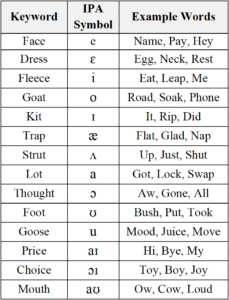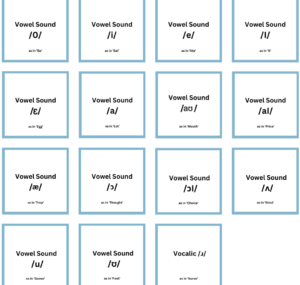Practicing American English Vowels to Improve Pronunciation
As a Speech-Language Pathologist (SLP), it’s important to help individuals by practicing American English vowels to improve pronunciation and clarity. American English has approximately 15 vowel sounds (including the vocalic ‘r’), which is about 3x the number of vowel sounds in other languages. This means that there is more room for error.

Because of the number of vowels in GenAm, there is more movement in the oral cavity to produce vowels, making vowels difficult for non-native speakers. The changes in jaw height, tongue position, and lip roundedness are very slight. All vowels are voiced, while about only half of English consonants are, and are most influenced by 3 distinctive features.
- Jaw Height: Think of the jaw as having 3 planes or levels of opening.
a. Slightly open (high)
b. Moderately open (mid)
c. Widely open (low) - Tongue Placement: front, central (middle), and back.
- Lip Roundedness: Unrounded, rounded, and retracted.
For more details, view my blog on Vowels of General American English HERE.

Practicing American English vowels
For word lists to use when practicing American English vowel sounds, check out our practice pages. Here, you will find word lists for each vowel sound in American English to help improve pronunciation. Each vowel sound practice page contains the following.
Words
- 25 one-syllable words
Phrases
- 18 phrases with a repeated occurrence
- 18 phrases with a single occurrence
Sentences
- 10 sentences with a repeated occurrence
- 10 sentences with a single occurrence
For more information on the vowel sounds in GenAm, check out my book, Speaking With an American Accent: A Guide to General American English Pronunciation, and our vowel lists on Teachers Pay Teachers.
Practice Activities
With accent modification, it’s important to focus on building phonological awareness and motor planning. To help clients do this, I recommend the following M.O.T.O.R. formats-
- Model- Model the stimuli and have the client repeat after you
- Opposites- Have the client say stimuli correctly and incorrectly for negative practice
- Tell apart- Have the client distinguish between the same/different productions for auditory discrimination
- Overcorrection- Have the client say stimuli while over-emphasizing the target
What techniques do you use to help build phonological awareness and motor planning? Let us know below ⬇️
